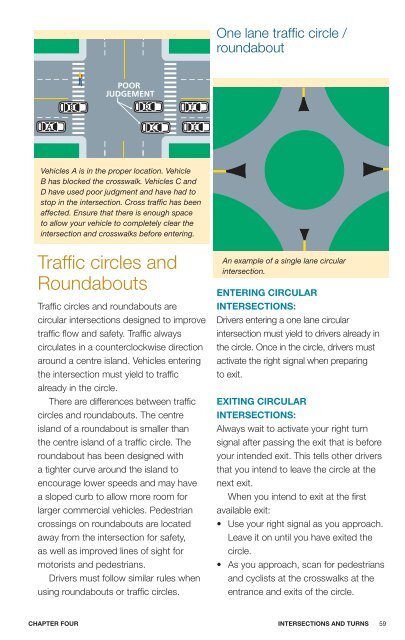DRIVER’S GUIDE
1POl7Ob
1POl7Ob
You also want an ePaper? Increase the reach of your titles
YUMPU automatically turns print PDFs into web optimized ePapers that Google loves.
One lane traffic circle /<br />
roundabout<br />
Vehicles A is in the proper location. Vehicle<br />
B has blocked the crosswalk. Vehicles C and<br />
D have used poor judgment and have had to<br />
stop in the intersection. Cross traffic has been<br />
affected. Ensure that there is enough space<br />
to allow your vehicle to completely clear the<br />
intersection and crosswalks before entering.<br />
Traffic circles and<br />
Roundabouts<br />
Traffic circles and roundabouts are<br />
circular intersections designed to improve<br />
traffic flow and safety. Traffic always<br />
circulates in a counterclockwise direction<br />
around a centre island. Vehicles entering<br />
the intersection must yield to traffic<br />
already in the circle.<br />
There are differences between traffic<br />
circles and roundabouts. The centre<br />
island of a roundabout is smaller than<br />
the centre island of a traffic circle. The<br />
roundabout has been designed with<br />
a tighter curve around the island to<br />
encourage lower speeds and may have<br />
a sloped curb to allow more room for<br />
larger commercial vehicles. Pedestrian<br />
crossings on roundabouts are located<br />
away from the intersection for safety,<br />
as well as improved lines of sight for<br />
motorists and pedestrians.<br />
Drivers must follow similar rules when<br />
using roundabouts or traffic circles.<br />
An example of a single lane circular<br />
intersection.<br />
ENTERING CIRCULAR<br />
INTERSECTIONS:<br />
Drivers entering a one lane circular<br />
intersection must yield to drivers already in<br />
the circle. Once in the circle, drivers must<br />
activate the right signal when preparing<br />
to exit.<br />
EXITING CIRCULAR<br />
INTERSECTIONS:<br />
Always wait to activate your right turn<br />
signal after passing the exit that is before<br />
your intended exit. This tells other drivers<br />
that you intend to leave the circle at the<br />
next exit.<br />
When you intend to exit at the first<br />
available exit:<br />
• Use your right signal as you approach.<br />
Leave it on until you have exited the<br />
circle.<br />
• As you approach, scan for pedestrians<br />
and cyclists at the crosswalks at the<br />
entrance and exits of the circle.<br />
CHAPTER FOUR<br />
INTERSECTIONS AND TURNS 59


